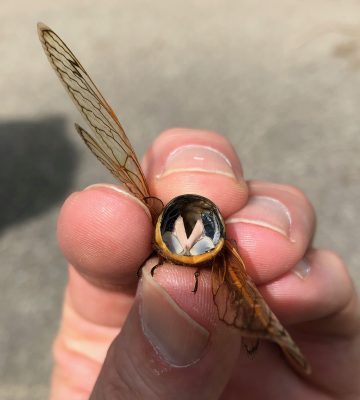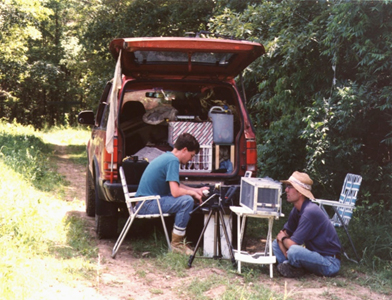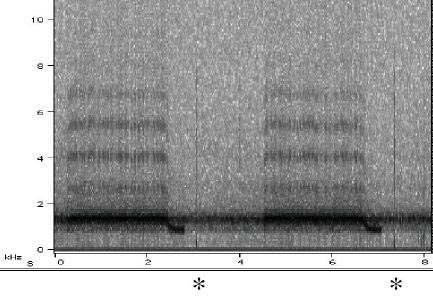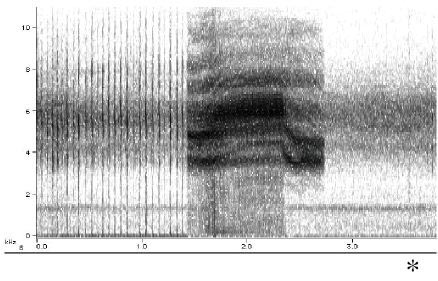As in nearly all cicada species, male periodical cicadas produce loud airborne acoustical signals, or “songs” using a pair of tymbals (alternate spelling timbals), or ridged membranes, found on the first abdominal segment.

The abdomen of a male cicada is hollow and may act as a resonating chamber; the songs of individuals are loud, and large choruses can be virtually deafening.

Females of most cicada species do not have sound-producing organs. Both sexes hear the sounds of the males as well as other sounds using membranous hearing organs called “tympana” found on the underside of the abdomen.
Over the course of an emergence, males congregate in “choruses” or singing aggregations, usually in high, sunlit branches. Females visit these aggregations and mate there, so choruses contain large numbers of both sexes.
Males of all Magicicada species (each described individually in the species section) produce alarm sounds when handled. Magicicada also have an unusually complex repertoire of signals used in various contexts associated with mating. These signals include acoustical calling songs that attract males and females to the chorus, and one or more acoustical courtship calls when approaching and attempting to mate with females. Different male acoustical signals have been described for the -decim and -cassini cognate species. Samples of most of these sounds are included on the relevant species pages. Within the species groups, acoustical signals may differ in pitch (frequency) and other characteristics, but the signals have have similar structures, so they can be described together. The functions of these signals are not entirely understood, but they have been given names to indicate their suspected function. The acoustical behaviors of the -decula species have not been as well characterized.

Female Magicicada produce timed “wing flick” signals in response to male calls, and the timing of this signal in relation to the male call is species-specific for species of the same life cycle. The signal consists of a quick flick of the wings that creates a broad-frequency sound that can vary from a gentle rustle to a sharp pop. Males are able perceive both the visual and acoustic components of the wing-flick.

A chorusing male perceiving a female signal increases his number of calls relative to movement distance, increasing the odds that he will elicit further responses from any nearby female. If the male receives multiple responses, he ceases sing-fly behavior, begins CI courtship, and engages in a signaling duet with the wing flicking female, evidently for the purpose of locating her. Between calls, duetting males often walk towards the signaling female, and while approaching, begin CII calling. After contacting the female or while preparing to mount, the male begins CIII calling, which he continues until he mounts and copulates. Under some circumstances, males engaged in duets acoustically obscure the downslurs of potential competitors, reducing the likelihood of a female response and increasing the likelihood that competing males will continue chorusing, depart and search elsewhere. Although female wing-flick signaling is known for many Australian and New Zealand cicadas (e.g., Lane 1995), this is the first reported incidence of female signaling in North American cicadas. For more detail about female signals in Magicicada, see Cooley and Marshall 2001.
Magicicada wing flick signals are exploited by parasites, such as Massospora cicadina.
Male signals
For more detail, see the Species page.
Alarm Sound: A rough buzz sound that males make when startled or handled; it is similar in pitch to the calling song, but coarser.
Calling song: An acoustical signal that attracts both males and females to the chorus. Male -decim alternate bouts of calling (usually 1-3 calls) with short flights, while -cassini and -decula may make just one call between flights (“sing-fly” behavior). The calls are approximately 1.5 – 3 seconds long in -decim and -cassini, and they are separated by silent gaps of about 1-2 seconds. The calling song of -decula is much longer, roughly 10-15 seconds in duration.
Court I (CI) Call: This acoustical signal is constructed of a series of phrases very similar to those used in the calling song, but more often without intervening bouts of flying or walking, and often with the gaps shortened. Males produce CI, CII, and CIII calls when courting a nearby female.
Court II (CII) Call: For -decim and -cassini, the phrases of this acoustical signal are similar to those in CI calls. However, there are no gaps between call phrases, and the phrases may be shortened, or include an upslur. Males usually produce the CII call shortly before attempting to mount a female. The Court II call in -decula, if it exists as in the other two species, has not been well-characterized.
Court III (CIII) Call: This acoustical signal consists of a continuous series of short, staccato buzzes, about 4-6 per second, in all three species. Males produce this signal while attempting to mount the female, stopping the sound only after engaging their genitalia.
Female signals:
Female wing flick signal: Females produce timed “wing flick” signals in response to male calls. The timing of this signal in relation to the male call is species-specific.



During the 2021 covid-19 pandemic lockdown, many of us had to quickly learn how to teach online. I was interested in greenscreen technology, so I made this video about periodical cicada wing flicking.